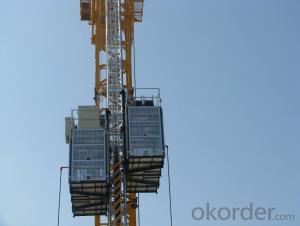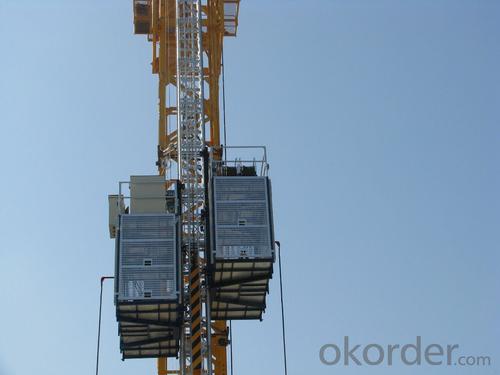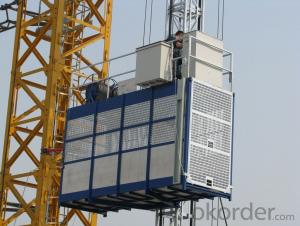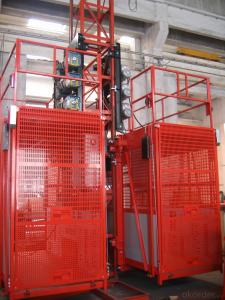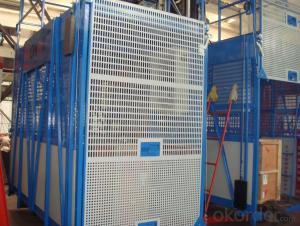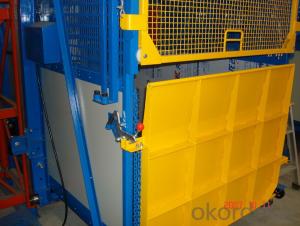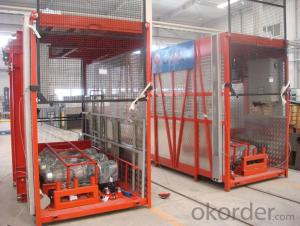construction hoist / builder's hoist/building hoist/SC270/270
- Loading Port:
- Tianjin
- Payment Terms:
- TT OR LC
- Min Order Qty:
- 1 unit
- Supply Capability:
- 100 unit/month
OKorder Service Pledge
Quality Product, Order Online Tracking, Timely Delivery
OKorder Financial Service
Credit Rating, Credit Services, Credit Purchasing
You Might Also Like
CMAX BUILDING HOIST SC270/270
DOUBLE CAGES
MAX LOADING CAPACITY= 2X2.7 T
CAGE SIZE= 3X1.5X2.5 M
MOTOR POWER= 2X3X18.5KW
MAST SECTION SIZE= 650X650X1508 MM
MAST SECTION & ATTACHED FRAME
TYPE OF SAFETY DEVICE: SAJ50-1.2 ADOPT HOT GALVANIZING PROCESSING
WITH OVERLOAD LIMITER & ALARM SYSTEM
- Q: Is it possible to utilize a building hoist for lifting materials during demolition projects?
- <p>While a building hoist is typically designed for construction purposes to lift materials and personnel, it is not advisable to use it for demolition work. Demolition involves hazardous conditions with falling debris and unstable structures, which can compromise the safety and integrity of the hoist. Instead, specialized equipment like wrecking balls, hydraulic shears, and cranes are more suitable for demolition tasks. These are engineered to handle the heavy loads and unpredictable conditions associated with breaking down structures safely.</p>
- Q: The user is inquiring about the possibility of purchasing a second-hand construction hoist.
- <p>Yes, you can buy a used building hoist. Many companies specialize in selling refurbished or used construction equipment, including building hoists. You can find them through online marketplaces, auction sites, or by contacting construction equipment dealers directly. It's important to inspect the hoist for any damages or wear and ensure it meets safety standards before purchase. Additionally, consider the hoist's age, maintenance history, and any warranties that might still be valid.</p>
- Q: Is it possible for non-professionals to overhaul or repair a hydraulic cylinder in a building hoist?
- <p>No, a hydraulic cylinder in a building hoist should not be overhauled or repaired by non-professionals. Hydraulic systems are complex and require specialized knowledge and skills to service. Attempting repairs without proper training can lead to serious safety hazards, equipment damage, and potential accidents. It is crucial to have a qualified technician or professional mechanic handle any maintenance or repairs to ensure safety and compliance with industry standards.</p>
- Q: This question asks if a building hoist can be utilized for the purpose of lifting heavy objects.
- <p>Yes, a building hoist is specifically designed for lifting heavy objects in construction settings. It is a mechanical device that can lift and lower materials such as concrete, bricks, and tools to various levels of a building under construction. Building hoists are engineered to handle substantial weight and are equipped with safety features to ensure secure and efficient operation. However, it is crucial to adhere to the hoist's weight capacity and safety guidelines to prevent accidents and ensure the proper use of the equipment.</p>
- Q: What is the main function of the construction elevator safety guard
- For safety device of construction hoist main effect is in the process of elevator used in times of emergency power, hit the brakes, let hoisting cage security attached on the guide rail frame, prevent the hoisting cage falling!
- Q: What measures should be taken to ensure safety when operating electric-motor powered building hoists?
- <p>When using electric-motor type building hoists, safety precautions include: ensuring all safety devices are in good working order, regularly inspecting and maintaining the hoist, following the manufacturer's guidelines, never overloading the hoist, keeping the hoist and its surroundings clean and free from obstructions, using proper lifting techniques, ensuring the hoist is stable and secure, wearing appropriate personal protective equipment, and training operators on the safe use of the hoist. Adhering to these precautions can significantly reduce the risk of accidents and ensure the safety of workers and the integrity of the construction process.</p>
- Q: What are the benefits and drawbacks of utilizing a building hoist in construction?
- <p>Advantages of using a building hoist include increased efficiency in material transportation, reduced manual labor, and improved safety by minimizing the risk of accidents associated with manual handling. They can also speed up construction timelines by allowing for continuous material flow. Disadvantages include the initial cost of the hoist, the need for regular maintenance, and potential downtime in case of mechanical failure. Additionally, building hoists may have limited capacity and may not be suitable for all types of construction projects, especially those with irregular shapes or limited space for installation.</p>
- Q: This question asks for an identification of the various types of lifting equipment that are specifically utilized in the context of building hoists.
- <p>Different types of lifting equipment used for building hoists include: 1. Electric Chain Hoists, which are versatile and suitable for various lifting tasks. 2. Manual Chain Hoists, that require manual operation and are used for lighter loads. 3. Electric Wire Rope Hoists, known for their high lifting capacity and durability. 4. Air Hoists, which are powered by compressed air and are ideal for environments where electricity is hazardous. 5. Geared Winches, used for pulling or lifting heavy loads with precision. 6. Jib Cranes, which provide a fixed or semi-fixed lifting solution in workshops. 7. Gantry Cranes, used for lifting heavy loads over a specific area. Each type serves specific purposes and is chosen based on the weight, environment, and specific requirements of the construction project.</p>
- Q: This question asks for a comparison between two types of building hoists: those that are electric and those that use electric motors. It seeks to understand the key distinctions between these two systems.
- <p>Electric building hoists are powered directly by electricity and typically use simpler electric motors for lifting and lowering loads. They are generally easier to install and operate, with direct control over the motor speed and direction. On the other hand, electric-motor building hoists are more complex, often incorporating advanced motor technologies and control systems. These hoists may offer features like variable speed control, energy efficiency, and smoother operation. The main differences lie in the sophistication of the motor and control systems, with electric-motor hoists often providing more precise control and better performance for heavy-duty applications.</p>
- Q: This question asks for the distinctions between two types of building hoists: manual and automatic.
- <p>Manual building hoists require human effort to operate, typically involving a pulley system and manual controls. They are generally less expensive but slower and more labor-intensive. Automatic building hoists, on the other hand, are motorized and can be programmed to lift and lower loads with minimal human intervention. They offer greater efficiency, speed, and safety, but come at a higher cost. Automatic hoists are also more suitable for high-rise construction due to their ability to handle heavier loads and operate over greater distances.</p>
Send your message to us
construction hoist / builder's hoist/building hoist/SC270/270
- Loading Port:
- Tianjin
- Payment Terms:
- TT OR LC
- Min Order Qty:
- 1 unit
- Supply Capability:
- 100 unit/month
OKorder Service Pledge
Quality Product, Order Online Tracking, Timely Delivery
OKorder Financial Service
Credit Rating, Credit Services, Credit Purchasing
Similar products
Hot products
Hot Searches
Related keywords
